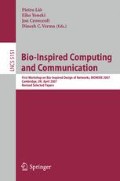Abstract
Vehicular sensor networks (VSNs) provide a collaborative sensing environment where mobile vehicles equipped with sensors of different nature (from chemical detectors to still/video cameras) inter-work to implement monitoring applications such as traffic reporting, environment monitoring, and distributed surveillance. In particular, there is an increasing interest in proactive urban monitoring where vehicles continuously sense events from streets, autonomously process sensed data (e.g., recognizing license plates), and possibly route messages to vehicles in their vicinity to achieve a common goal (e.g., to permit police agents to track the movements of specified cars). MobEyes is a middleware solution to support VSN-based proactive urban monitoring applications, where the agents (e.g., police cars) harvest metadata from regular VSN-enabled vehicles. Since multiple agents collaborate in a typical urban sensing operation, it is critical to design a mechanism to effectively coordinate their operations to the area where new information is rich in a completely decentralized and lightweight way. We present a novel agent coordination algorithm for urban sensing environments that has been designed based on biological inspirations such as foraging, stigmergy, and Lévy flight. The reported simulation results show that the proposed algorithm enables the agents to move to “information patches” where new information concentration is high, and yet limits duplication of work due to simultaneous presence of agents in the same region.
This research is supported through participation in the International Technology Alliance sponsored by the U.S. Army Research Laboratory and the U.K. Ministry of Defense under Agreement Number W911NF-06-3-0001, and; by ARMY MURI under funding W911NF0510246.
Access this chapter
Tax calculation will be finalised at checkout
Purchases are for personal use only
Preview
Unable to display preview. Download preview PDF.
References
Intanagonwiwat, C., Govindan, R., Estrin, D.: Directed Diffusion: a Scalable and Robust Communication Paradigm for Sensor Networks. In: ACM MOBICOM 2000, Boston, MA, USA (2000)
Lee, U., Magistretti, E., Zhou, B., Gerla, M., Bellavista, P., Corradi, A.: MobEyes: Smart Mobs for Urban Monitoring with a Vehicular Sensor Network. IEEE Wireless Communications 13(5) (Septmber 2006)
Hull, B., Bychkovsky, V., Chen, K., Goraczko, M., Miu, A., Shih, E., Zhang, Y., Balakrishnan, H., Madden, S.: CarTel: A Distributed Mobile Sensor Computing System. In: ACM SenSys, Boulder, CO, USA, October-November (2006)
Passino, K.M.: Biomimicry for Optimization, Control and Automation. Springer, Heidelberg (2005)
Kim, T., Jung, S., Cho, K.: Investigations into the Design Principles in the Chemotactic Behavior of Escherichia Coli. Biosystems (2007)
Levy, P.: Theorie de l’addition des variables aleatoires. Gauthier-Villars, Paris (1954)
Reynolds, A.M., Frye, M.A.: Free-Flight Odor Tracking in Drosophila Is Consistent with an Optimal Intermittent Scale-Free Search. PLoS ONE 2(4) (2007)
Detrain, C., Deneubourg, J.L.: Complexity of Environment and Parsimony of Decision Rules in Insect Societies. Biol. Bull. 202(3), 268–274 (2002)
Theraulaz, G., Bonbeau, E.: A Brief History of Stigmergy. Artificial Life 5(2), 97–116 (1999)
Bloom, B.H.: Space/Time Trade-offs in Hash Coding with Allowable Errors. CACM 13(7), 422–426 (1970)
Grossglauser, M., Vetterli, M.: Locating Nodes with EASE: Mobility Diffusion of Last Encounters in Ad Hoc Networks. In: IEEE INFOCOM, San Francisco, CA, USA, March-April (2003)
Stephens, D., Krebs, K.: Foraging Theory. Princeton University Press, NJ (1986)
Jackson, D.E., Ratnieks, F.L.: Primer: Communications in Ants. Current Biology 16(15), 570–574 (2006)
Bartumeus, F., da Luz, M.G.E., Viswanathan, G.M., Catalan, J.: Animal search strategies: a quantitative random-walk analysis. Ecology 86, 3078–3087 (2005)
Viswanathan, G., Buldyrev, S.V., Havlin, S., da Luz, M.G.E., Raposo, E.P., Stanley, H.E.: Optimizing the success of random searches. Nature 401, 911–914 (1999)
Bai, F., Sadagopan, N., Helmy, A.: The IMPORTANT Framework for Analyzing the Impact of Mobility on Performance of Routing for Ad Hoc Networks. Ad Hoc Networks Journal - Elsevier 1, 383–403 (2005)
Author information
Authors and Affiliations
Editor information
Editors and Affiliations
Rights and permissions
Copyright information
© 2008 Springer-Verlag Berlin Heidelberg
About this paper
Cite this paper
Lee, U., Magistretti, E., Gerla, M., Bellavista, P., Liò, P., Lee, KW. (2008). Bio-Inspired Multi-agent Collaboration for Urban Monitoring Applications. In: Liò, P., Yoneki, E., Crowcroft, J., Verma, D.C. (eds) Bio-Inspired Computing and Communication. BIOWIRE 2007. Lecture Notes in Computer Science, vol 5151. Springer, Berlin, Heidelberg. https://doi.org/10.1007/978-3-540-92191-2_19
Download citation
DOI: https://doi.org/10.1007/978-3-540-92191-2_19
Publisher Name: Springer, Berlin, Heidelberg
Print ISBN: 978-3-540-92190-5
Online ISBN: 978-3-540-92191-2
eBook Packages: Computer ScienceComputer Science (R0)

